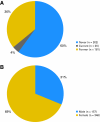Incidence of EGFR exon 19 deletions and L858R in tumor specimens from men and cigarette smokers with lung adenocarcinomas
- PMID: 21482987
- PMCID: PMC3296671
- DOI: 10.1200/JCO.2010.32.6181
Incidence of EGFR exon 19 deletions and L858R in tumor specimens from men and cigarette smokers with lung adenocarcinomas
Abstract
Purpose: EGFR mutations underlie the sensitivity of lung cancers to erlotinib and gefitinib and can occur in any patient with this illness. Here we examine the frequency of EGFR mutations in smokers and men.
Methods: We determined the frequency of EGFR mutations and characterized their association with cigarette smoking status and male sex.
Results: We tested 2,142 lung adenocarcinoma specimens for the presence of EGFR exon 19 deletions and L858R. EGFR mutations were found in 15% of tumors from former smokers (181 of 1,218; 95% CI, 13% to 17%), 6% from current smokers (20 of 344; 95% CI, 4% to 9%), and 52% from never smokers (302 of 580; 95% CI, 48% to 56%; P < .001 for ever v never smokers). EGFR mutations in former or current smokers represented 40% of all those detected (201 of 503; 95% CI, 36% to 44%). EGFR mutations were found in 19% (157 of 827; 95% CI, 16% to 22%) of tumors from men and 26% (346 of 1,315; 95% CI, 24% to 29%) of tumors from women (P < .001). EGFR mutations in men represented 31% (157 of 503; 95% CI, 27% to 35%) of all those detected.
Conclusion: A large number of EGFR mutations are found in adenocarcinoma tumor specimens from men and people who smoked cigarettes. If only women who were never smokers were tested, 57% of all EGFR mutations would be missed. Testing for EGFR mutations should be considered for all patients with adenocarcinoma of the lung at diagnosis, regardless of clinical characteristics. This strategy can extend the use of EGFR tyrosine kinase inhibitors to the greatest number individuals with the potential for substantial benefit.
Conflict of interest statement
Authors' disclosures of potential conflicts of interest and author contributions are found at the end of this article.
Figures
Comment in
-
Testing epidermal growth factor receptor mutations in patients with non-small-cell lung cancer to choose chemotherapy: the other side of the coin.J Clin Oncol. 2011 Oct 1;29(28):3835-7; author reply 3837-9. doi: 10.1200/JCO.2011.36.7847. Epub 2011 Aug 29. J Clin Oncol. 2011. PMID: 21876080 No abstract available.
Similar articles
-
Impact of cigarette smoking on response to epidermal growth factor receptor (EGFR)-tyrosine kinase inhibitors in lung adenocarcinoma with activating EGFR mutations.Lung Cancer. 2014 May;84(2):196-202. doi: 10.1016/j.lungcan.2014.01.022. Epub 2014 Feb 3. Lung Cancer. 2014. PMID: 24629638
-
Use of cigarette-smoking history to estimate the likelihood of mutations in epidermal growth factor receptor gene exons 19 and 21 in lung adenocarcinomas.J Clin Oncol. 2006 Apr 10;24(11):1700-4. doi: 10.1200/JCO.2005.04.3224. Epub 2006 Feb 27. J Clin Oncol. 2006. PMID: 16505411
-
Molecular epidemiology of EGFR and KRAS mutations in 3,026 lung adenocarcinomas: higher susceptibility of women to smoking-related KRAS-mutant cancers.Clin Cancer Res. 2012 Nov 15;18(22):6169-77. doi: 10.1158/1078-0432.CCR-11-3265. Epub 2012 Sep 26. Clin Cancer Res. 2012. PMID: 23014527 Free PMC article.
-
Lung cancer in never-smokers. Does smoking history matter in the era of molecular diagnostics and targeted therapy?J Clin Pathol. 2013 Oct;66(10):839-46. doi: 10.1136/jclinpath-2012-201296. Epub 2013 May 9. J Clin Pathol. 2013. PMID: 23661716 Review.
-
Tyrosine kinase inhibitors for epidermal growth factor receptor gene mutation-positive non-small cell lung cancers: an update for recent advances in therapeutics.J Oncol Pharm Pract. 2016 Jun;22(3):461-76. doi: 10.1177/1078155215577810. Epub 2015 Apr 8. J Oncol Pharm Pract. 2016. PMID: 25855240 Review.
Cited by
-
Tackling Drug Resistance in EGFR Exon 20 Insertion Mutant Lung Cancer.Pharmgenomics Pers Med. 2021 Mar 9;14:301-317. doi: 10.2147/PGPM.S242045. eCollection 2021. Pharmgenomics Pers Med. 2021. PMID: 33727854 Free PMC article. Review.
-
Screening for germline EGFR T790M mutations through lung cancer genotyping.J Thorac Oncol. 2012 Jun;7(6):1049-52. doi: 10.1097/JTO.0b013e318250ed9d. J Thorac Oncol. 2012. PMID: 22588155 Free PMC article.
-
Impact of active smoking on survival of patients with metastatic lung adenocarcinoma harboring an epidermal growth factor receptor (EGFR) mutation.Bosn J Basic Med Sci. 2016 Nov 10;16(4):280-285. doi: 10.17305/bjbms.2016.1380. Bosn J Basic Med Sci. 2016. PMID: 27371767 Free PMC article.
-
Targeting the Fibroblast Growth Factor Receptor (FGFR) Family in Lung Cancer.Cells. 2021 May 10;10(5):1154. doi: 10.3390/cells10051154. Cells. 2021. PMID: 34068816 Free PMC article. Review.
-
Molecular epidemiology of lung cancer and geographic variations with special reference to EGFR mutations.Transl Lung Cancer Res. 2014 Aug;3(4):205-11. doi: 10.3978/j.issn.2218-6751.2014.08.04. Transl Lung Cancer Res. 2014. PMID: 25806302 Free PMC article. Review.
References
-
- Lynch TJ, Bell DW, Sordella R, et al. Activating mutations in the epidermal growth factor receptor underlying responsiveness of non-small-cell lung cancer to gefitinib. N Engl J Med. 2004;350:2129–2139. - PubMed
-
- Paez JG, Janne PA, Lee JC, et al. EGFR mutations in lung cancer: Correlation with clinical response to gefitinib therapy. Science. 2004;304:1497–1500. - PubMed
-
- Pao W, Kris MG, Iafrate AJ, et al. Integration of molecular profiling into the lung cancer clinic. Clin Cancer Res. 2009;15:5317–5322. - PubMed
-
- Mok TS, Wu YL, Thongprasert S, et al. Gefitinib or carboplatin-paclitaxel in pulmonary adenocarcinoma. N Engl J Med. 2009;361:947–957. - PubMed
MeSH terms
Substances
LinkOut - more resources
Full Text Sources
Other Literature Sources
Molecular Biology Databases
Research Materials
Miscellaneous


